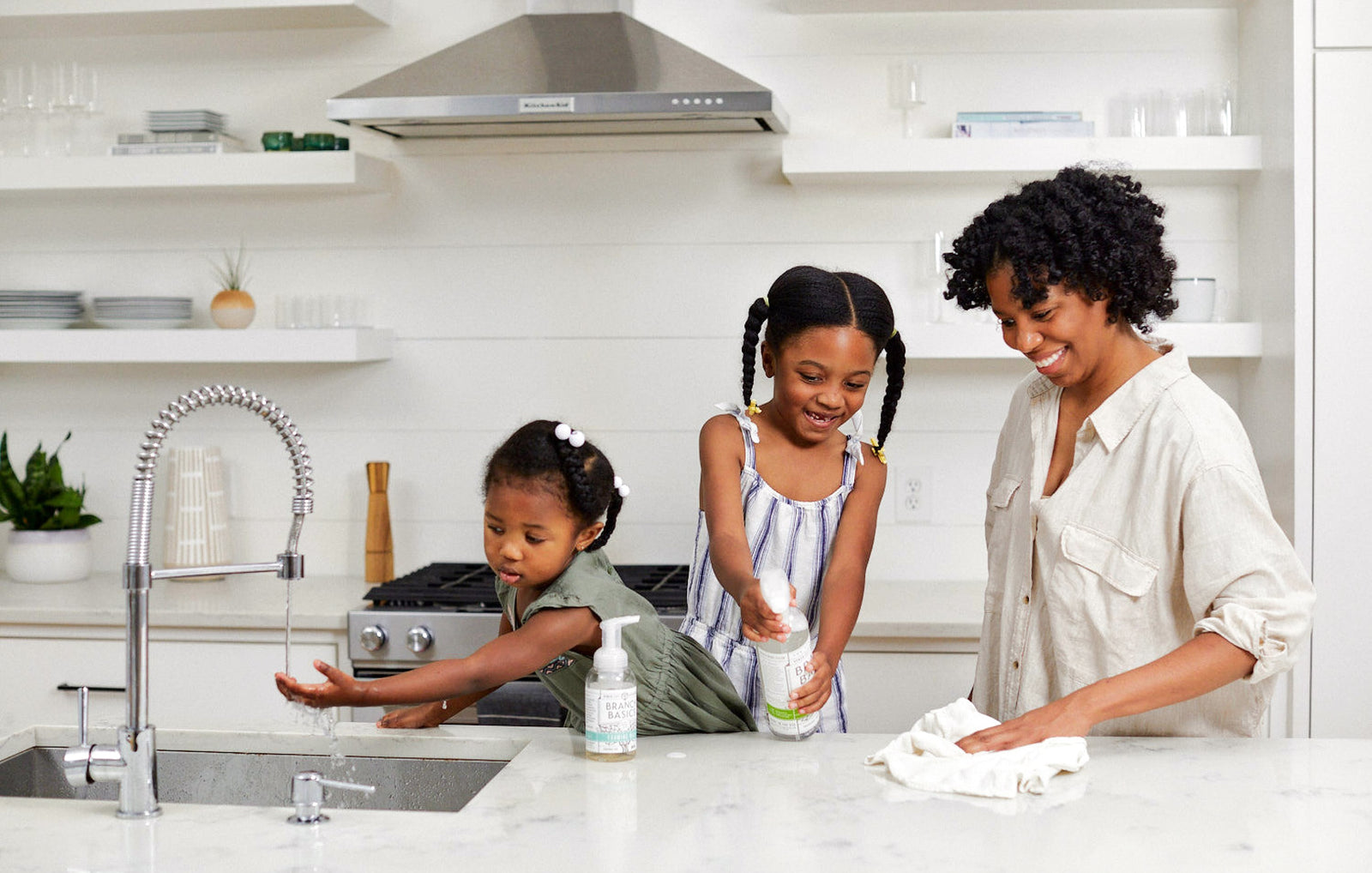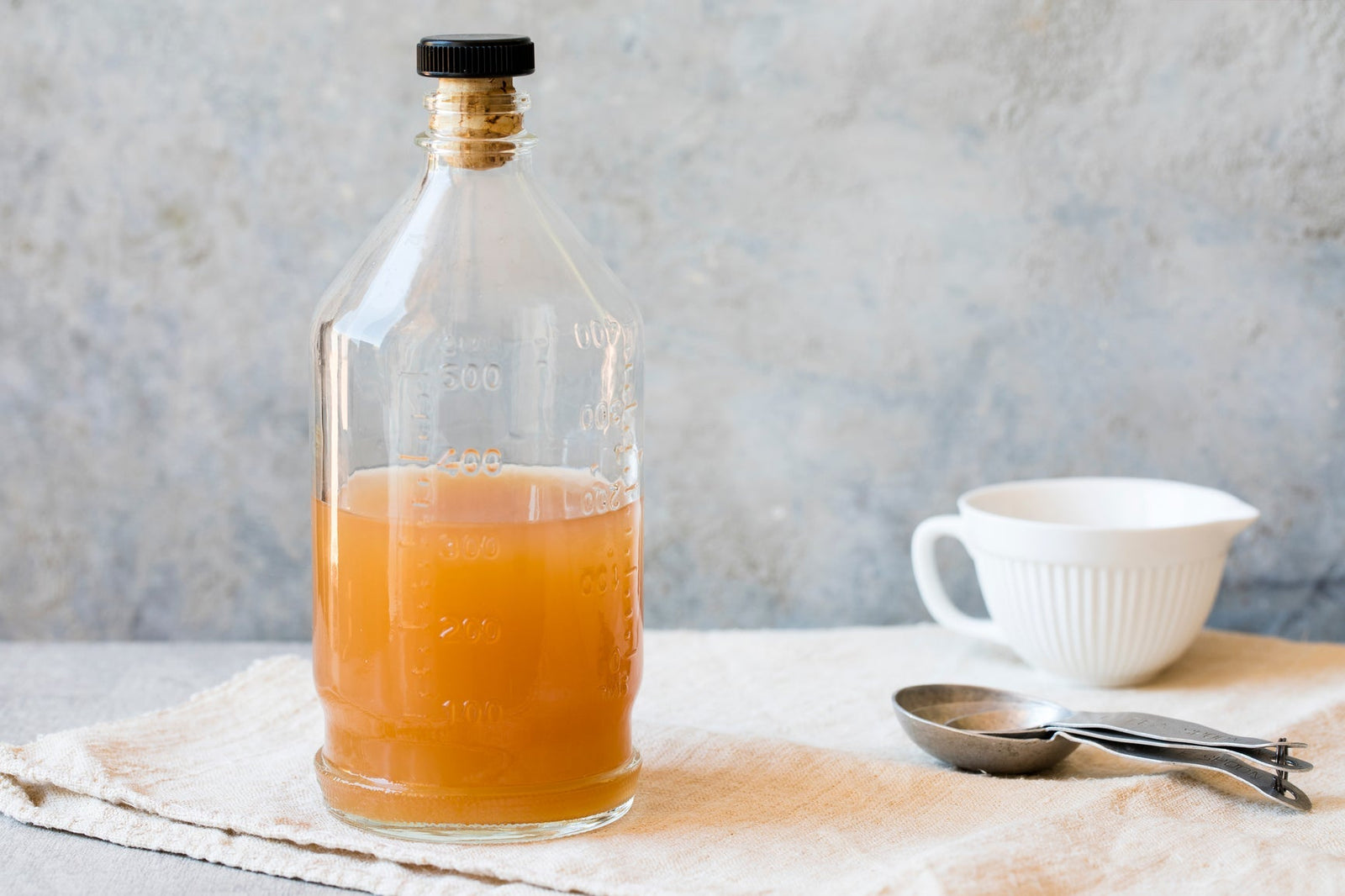What is Ammonia Used For & How to Avoid it | Branch Basics

Ammonia is a common ingredient in cleaning products and disinfectants.
However, like so many other cleaning ingredients, it can be very dangerous if inhaled, ingested, or absorbed by the skin.
In this article, you’ll learn what ammonia is used for in various cleaning products, how to avoid it, and what to use instead.
What is Ammonia?
Ammonia is one of the top-produced industrial chemicals in the United States, with about 80% of the world’s supply used in chemical fertilizer.
The type of ammonia used in cleaning products like all-purpose ammonia or household ammonia is known as ammonium hydroxide. It has excellent degreasing, shining, fast-drying, stain-removing, dirt-busting, and disinfectant properties.
Natural ammonia is also produced and excreted by the body as a metabolic by-product and is found in nature.
However, many clever marketers have tried to convince people that the synthetic/human-made ammonia is the same as ammonia produced and excreted by the body, so therefore, it’s safe and natural.
However, that is simply not true. And even the ammonia produced by the body can become toxic if too much builds up in the body.
How Can Ammonia Harm Me?
Ammonia is irrefutably harmful if inhaled, ingested, or absorbed by the skin, especially in large amounts.
Bear in mind a large amount could mean too much all at once or too much over time, such as active or passive exposure from cleaning products or industrial ag products every day or week.
Some side effects of ammonia exposure include respiratory irritations, severe skin burns, rapid skin and eye irritation, blindness, organ damage, and even death.
Household or all-purpose ammonia is typically 5-10% Ammonia Hydroxide diluted with water and is touted as safe for household use.
Yet, one must only look at the multiple warning labels on the bottle, including instructions to call poison control and keep away from children and pets, to see that it is anything but safe.
This is why it is recommended you use ammonia in a well-ventilated area, never ingest it, and take care to use gloves.
You must also avoid cross-contamination with other cleaning products, like bleach, which will create a toxic gas if combined with ammonia.
Learn more in: 5 Ammonia-Free Cleaning Products.
5 Common Use Cases for Ammonia & Natural Alternatives
As mentioned previously, ammonia is beloved in the cleaning industry for its disinfectant, fast-drying, stain removing, degreasing, and shining properties.
Today, it is most commonly used in window and glass cleaners and some disinfectants, although some people still use straight ammonia for household cleaning.
The following are five common use cases for ammonia.
1. Removing Stains
Ammonia is a popular ingredient in various stain removers, including carpet cleaners, carpet stain removers, and certain laundry products.
Ammonia alternatives for stain removal:
- Oil stains
- All natural baby powder
- Branch Basics Concentrate - difficult oil stains - try the concentrate!
- Basics All-Purpose
- Branch Basics Oxygen Boost as a soak or mixed with water and applied to carpets (test for colorfastness on carpets)
- Baking soda
- Corn starch
- Distilled white vinegar
- Lemon juice
- Salt
- Natural dish soap or dish soap + cornstarch or natural baby powder
- Food stains
- Branch Basics All-Purpose
- Branch Basics Oxygen Boost as a soak or mixed with water and applied to carpets (test for colorfastness on carpets)
- Baking soda
- Distilled white vinegar
- Lemon juice
- Club soda
- Natural enzyme-based stain removers, hydrogen peroxide (for light-colored clothes and fabrics)
- Pet stains
- Branch Basics All-Purpose
- Branch Basics Oxygen Boost as a soak or mixed with water and applied to carpets (test for colorfastness on carpets)
- Vinegar
- Baking soda
- Salt
- Cornstarch + vinegar
- Hydrogen peroxide (for light-colored clothes and fabrics)
- Tea or coffee stains
- Pour boiling water over the stain until it’s gone
- Branch Basics All-Purpose
- Branch Basics Oxygen Boost as a soak or mixed with water and applied to carpets (test for colorfastness on carpets)
- Distilled white vinegar
- Baking soda
- Hydrogen peroxide (for light-colored clothes and fabrics)
- Blood stains
- Branch Basics All-Purpose
- Branch Basics Oxygen Boost as a soak or mixed with water and applied to carpets (test for colorfastness on carpets)
- Club soda, natural enzyme-based stain removers, hydrogen peroxide (for light-colored clothes and fabrics)
- Sweat and armpit stains
- Branch Basics All-Purpose
- Branch Basics Oxygen Boost as a soak or mixed with water and applied to carpets (test for colorfastness on carpets)
- Distilled white vinegar
- Baking soda
- Grass stains
- Branch Basics All-Purpose
- Branch Basics Oxygen Boost as a soak
- Natural liquid dish soap
- Hydrogen peroxide
- Ink and marker stains
- Branch Basics All-Purpose
- Branch Basics Oxygen Boost as a soak or mixed with water and applied to carpets (test for colorfastness on carpets)
- Rubbing alcohol
- Distilled white vinegar
- Baking soda + toothpaste
- Nail Polish Stains
- Branch Basics Concentrate
- Hydrogen Peroxide
- Branch Basics Laundry
For more ammonia-free natural stain removal tips, click the links above and see: How To Get Stains Out Of Everything With Branch Basics [Complete Guide].
2. Bathroom Cleaning
Ammonia is super common in bathroom cleaners, including window cleaners, all-purpose, toilet bowl cleaners, and more.
Fortunately, it’s also completely unnecessary and easily replaced.
Ammonia alternatives for bathroom cleaning:
- Surfaces
- Branch Basics All-Purpose or Bathroom
- DIY liquid castile soap spray
- Lemon juice (alone or diluted 50:50 with water)
- Distilled white vinegar (alone or diluted 50:50 with water)
- Dry steam cleaner or steam surface cleaner
- Peroxide
- Toilets
- Branch Basics Bathroom + Oxygen Boost
- Hydrogen peroxide
- Lemon juice (alone or diluted 50:50 with water)
- Distilled white vinegar (alone or diluted 50:50 with water)
- Baking soda
- Dry steam cleaner or steam surface cleaner for seat, handle, lids, etc.
- Pumice stones for stubborn toilet rings or hard water stains
- Tubs and showers
- Branch Basics Bathroom + Oxygen Boost
- Lemon juice (alone or diluted 50:50 with water)
- Distilled white vinegar (alone or diluted 50:50 with water)
- Baking soda
- DIY liquid castile soap cleaner: Liquid castile soap + baking soda + water to make a creamy paste
- Grout
- Branch Basics Bathroom + Oxygen Boost
- Distilled white vinegar + baking soda
- Tile and floor
- Branch Basics All-Purpose or custom floor dilution
- Distilled white vinegar + water (50:50)
- Lemon juice + water (50:50)
- Liquid castile soap + water
- Dry steam cleaner
- Steam mop
- Mirrors and glass
- Branch Basics Streak-Free
- Hydrogen peroxide
- Distilled white vinegar
- Rubbing alcohol
- Dry steam cleaner
- Soap scum
- Undiluted distilled white vinegar
- Undiluted lemon juice
- Faucets and fixtures
- Branch Basics All-Purpose or Bathroom
- Distilled white vinegar
- Peroxide
- DIY liquid castile soap cleaner: Liquid castile soap + baking soda + water to make a creamy paste
- Mold and mildew
- Baking soda + hydrogen peroxide paste. Scrub on. Let dwell for 15-30 minutes. Wipe clean.
- Dry steam cleaner
Get more natural bathroom cleaning tips in:
- 11 Safe And Effective Natural Bathroom Cleaning Essentials
- How To Clean Your Bathroom Naturally With Branch Basics
- How to Naturally Disinfect Surfaces [Complete Guide]
3. Jewelry Cleaning
Did you know ammonia is a popular ingredient in jewelry cleaners?
Apart from the toxicity factor, this harsh chemical can damage precious stones and wear down precious metals over time.
Instead, try out these gentler, human-safe alternatives.
Ammonia alternatives for jewelry cleaning:
- Branch Basics All-Purpose or Foaming Wash
- Gentle natural dish soap
- Baking soda
- Distilled white vinegar
- Toothpaste (removes tarnish but won’t shine very well)
Note, these cleaners may not be suitable for all types of jewelry.
Get all the details, including step-by-step instructions in: How To Clean Jewelry and How To Clean Jewelry With Branch Basics
4. Degreasing
Ammonia is an effective degreaser, but natural products can work just as well. Here’s how to use them.
Ammonia alternatives for degreasing:
- Branch Basics All-Purpose, Bathroom, or Concentrate (All-Purpose can even be used on car engines)
- Baking soda
- Citrus essential oils
- Distilled white vinegar
- Lemon juice
- Liquid castile soap
- Natural dish soap
- Salt
Recipe for a simple and natural DIY degreaser:
Ingredients:
- 1/4 cup natural dish soap or liquid castile soap
- 5-10 drops organic/wild-crafted steam-distilled 100% pure lemon or orange essential oil
- 1 cup baking soda
- 1/4 cup vinegar (white or apple cider)
- 1/4 cup water
To use:
- Combine everything in a spray bottle and shake.
- Spray on grease or oil spots, and wipe off.
5. Glass Cleaner
Ammonia makes an effective glass cleaner because of its cleaning, degreasing, and fast-drying properties.
However, various safer alternatives provide equal cleaning and streak-free power.
Ammonia glass cleaner alternatives
- Branch Basics Streak-Free
- Hydrogen peroxide
- Distilled white vinegar
- Rubbing alcohol
- Vodka
- Dry steam cleaner
- Traditional steam cleaners
Related reading: Best Glass Cleaners Without Ammonia
How to Avoid Ammonia-Based Products With Label Checking
Unlike other cleaning ingredients, ammonia is generally easy to spot on labels…or by using your nose!
Just look for “ammonia” or “ammonia hydroxide” and remember even “green,” “eco-conscious,” or “organic” cleaners may contain ammonia.
We also recommend sites like EWG’s (Environmental Working Group) Skin Deep Database to vet products before purchasing. Look for EWG-verified products and those rated 1-2.
Label Red Flags
In addition to looking for ammonia on labels, red flags on any cleaning product include:
- No ingredient list
- Fragrance
- Antibacterial
- Kills 99.9% of germs
- Antiseptic
- Disinfectant
- Warning
- Caution
- Hazardous material or “safe disposal”
- Call poison control
- Danger
- Poison
- Skin irritant
- Eye irritant
- Lung irritant
- Window or glass cleaners that say “with vinegar” may also contain ammonia
Note: Many products with the word “caution” or “irritant” may have safe ingredients (any powder, for example, can irritate the lungs), but there are common sense usage recommendations.
Label Green Flags
Look for products with badges and certifications like “Made Safe Certified,” “EWG-Verified,” “Third-party tested,” and “Leaping Bunny Certified” or “Cruelty-Free.”
Although claims like “eco-friendly,” “from nature,” “green,” “water-based,” “all-natural,” “vegan,” and others may sound great (and may be true), there is no way to verify their validity, and they are often used to greenwash products.
Remember, ammonia is considered by many to be a “natural” ingredient, so its use is ubiquitous throughout the green and conventional cleaning products.
Learn more in: Are They Greenwashing? How To Decipher A Brand’s Sustainability Claims and 3 Tools You Need To Become Your Own Product Advocate
Create a Safer Home With Branch Basics
Ammonia may be a cheap and effective cleaner, but its risks clearly outweigh its benefits.
Instead, we hope you’ll test out these recommended ammonia alternatives yourself.
They work wonders and will help you create a safer, cleaner, and healthier home.
If you’re looking for an ammonia-free cleaning system that’s safe, effective, and affordable, you’ve got to check out Branch Basics Starter Kits.
Our human-safe, earth-friendly, Made-Safe Certified, Leaping Bunny Certified, plant- and mineral-based cleaning system uses Branch Basics Concentrate plus water to replace every cleaner & laundry product (All-Purpose, Bathroom, Streak-Free, Laundry, and Foaming Wash) in your home.
Our starter kits also come with Oxygen Boost, a powerful 100% mineral-based bleach alternative, soaking aid, laundry booster, stain remover, and scouring agent.
These two simple products clean surfaces, remove stains, deodorize, launder, clean jewelry, decks, cars, floors, toys, produce, stainless steel, glass, carpets, rugs, walls, ovens, appliances, cars, garages, hands, face, pets, babies, hair, and everything in between.
To learn more, see: How To Get Started With Your Branch Basics Kit.
Ready to test us out? Check out Branch Basics Premium Starter Kits in refillable plastic or glass, or give us a trial run with Branch Trial Kit for just $5.00.
Categories

Marilee Nelson
Marilee Nelson is an Environmental Toxins expert who has spent nearly 30 years advocating for the chemically-sensitive and chronically-ill. She is a Board Certified Nutritionist, Certified Bau-Biologist and Bau-Biology Inspector and specializes in Food As Medicine. She has helped thousands of families and individuals identify, heal and recover from toxic exposures and is on a mission to revolutionize the way American families view their health.








